#historical cooking
Text

I made an authentic 1910s recipe on Armistice Day today: originally published in The Bayonne Herald and Greenview Register in 1915, and shared on Bluesky by Kristy Baxter.

It took about 17 minutes at 450 F for gooey but not very runny eggs, adjust to your preferences. I have experimented with oven roasted tomatoes for English Breakfast, and I find that they always need more time in the oven.
For seasoning, I used salt, pepper, powdered garlic, dried herbs, and a dash of adobo seasoning. More fresh grated pepper and some parmesan cheese were excellent additions to the cooked eggs, I will definitely make 1915 Eggs in Tomatoes again.

#1910s#food#culinary history#cooking with shaun#recipe#historical cooking#great war era#1915#œuf cocotte en tomate#eggs in tomatoes#foodways#traditional recipes#described#blue willow#chinoiserie#traditional food
65 notes
·
View notes
Text
Medieval Food - Let's Talk
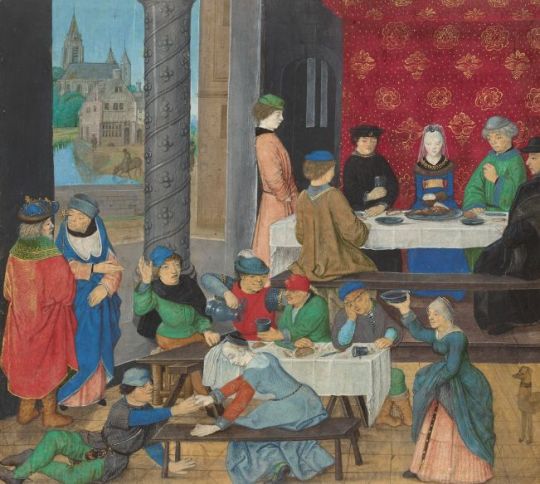
You know what? One week later and I am still fairly annoyed.
First of all: Yes, I am very much aware that technically one should not take MatPat too seriously and that for the most part if anything the “XY Theory” channels are just mild entertainment… But let’s face it: There are thousands of kids watching this, who are gonna take it seriously. And even a lot of adults, who do not know better.
So, as this is a topic near and dear to my heart and also a topic that the internet just throws around so much misinformation around on, let me talk a bit about Medieval Cuisine.
The Offense
Let me start with the thing that annoyed me so much, even though the issue is not so much about the issue at hand and more about the missing context in this one. Last week the @gametheoreoy sister channel Food Theory uploaded a video on Medieval Cuisine. While some of the information in there was good and included some important stuff that a lot of folks get wrong (like the fact that tomatoes, potatoes and maize were foods that came from the Americas and hence were not around in medieval Europe), the thing that annoyed me most about the video was… that MatPat and team absolutely ignored the fact that the place in question, medieval "Spain", was in that timeframe under under Black Muslim rule. In fact, there was technically no “Spain” at the time in question. Not as we imagine it today. Instead there was Al-Andalus (or Andalusia, how we know it today) and Leon-Castille. While the latter was Catholic, yes, the former was Muslim.
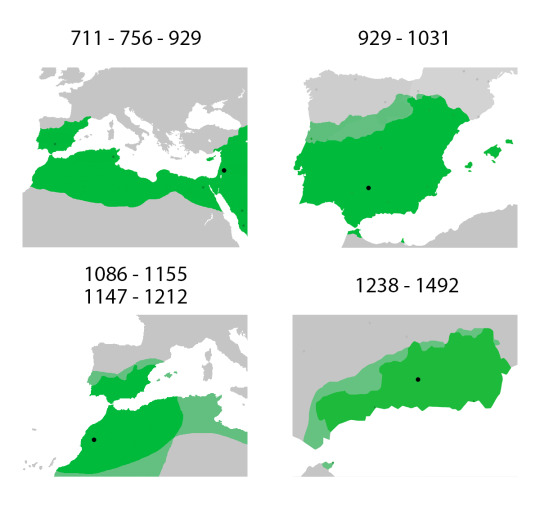
This really makes me angry, as it once again just plays into the misconception that medieval Europe was all white and Christian. Which it was not. For most of the medieval period, large chunks of the Iberian peninsula were under Muslim rule, which was also a reason that a lot of persecuted minorities – for example Jews, some Sinti and Romani people and also followers of Christian sects, that were not Catholic – fled there, as at that time Muslim rulers tended to not persecute those minorities, while the Catholic church did.
Now, it should be said that under Muslim rule, nobody who was not Muslim was forced to follow Muslim religious law, as not eating pork. But from what we know there was a lot less pork consumed on the Iberian peninsula at the time, than elsewhere in Europe. Instead, lamp, veal, dear and poultry were the more popular meats.
And I am sorry, MatPat, but talking about this part of Europe in the medieval times without speaking about Muslim rule is just a super bad look. Because it erases some important history.
While we are on it
But while we are on it, allow me to talk about Medieval cuisine, because bow, howdy, do people get this topic wrong.
For reference: No, I am no historian. But I am an autistic person, who spend a couple years hyperfixating on the history of food and henceforth getting annoyed with a lot of books, movies and the like, whenever they are depicting food in the medieval times.
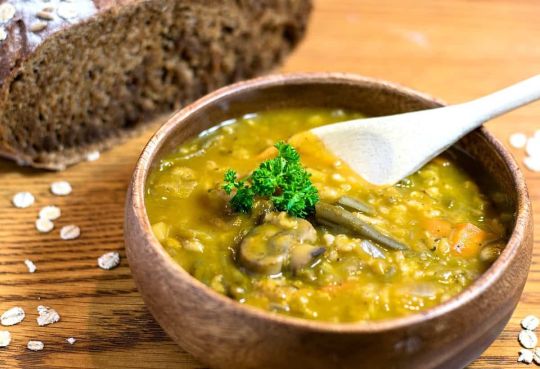
Some things that I have seen in those contexts are, obviously, the tomatoes, potatoes and maize. But especially potatoes. Oh, boy, howdy, do people love depicting medieval folks eating potatoes. Maybe not surprising, given that the potato is in fact a main stay in modern day European cuisine. Also, obviously, the potato has still the reputation of a pauper’s food, which then easily combines with the common misconception of “people in medieval times were very poor and ate very poorly”. But, again, the potato would not reach Europe until probably 1519, though it would still be a while until people figured out how to eat potatoes (given that the green parts of the plants are in fact poisonous). Same goes for tomatoes, all sorts of peppers and again maize (corn, for the Americans).
Meanwhile people would go up to me and tell me seriously that “people in the medieval times did not have noodles”, which is… ridiculous, given that noodles and all sorts of pasta were around in Europe since ancient times. Even the old Greeks and Romans ate noodles, just not in those many fancy forms we know today. For the most part in medieval times people ate some sort of ribbon noodle, something we might call ravioli today, just noodles cut into square and something that was called lasagna, though it did not resemble today’s lasagna much. But noodles there were.

Another food that people do not associate with the medieval times, even though it was very much around in Southern European places, was rice. Other than the Americas, people kinda always knew about Asia and were trading with them. Even in Roman times. Which lead to the Romans actually cultivating a strain of rice, that did well enough in Europe. Now, while rice was not a common food in medieval Europe, it was certainly around.
Probably the weirdest thing, someone claimed about medieval food, was, that there was no “stew” around in medieval times, because it was “too complicated for the people back then”. You know, stew, the food where you basically just put a lot of different stuff into one pot and cook it… “Too complicated”. Honestly, I do not know what to say about that. Stew was not only around, but also very common. Especially as a lot of people did not have actual kitchens and were instead cooking their food over their fireplace, that often enough would only allow for one pot.
The thing about meat
One thing that MatPat gets mostly right – though, again not for Al-Andalus/Spain, because things were different there – is the bit about meat in the middle ages, though while he says the right thing here, he kinda misses a bit of context.
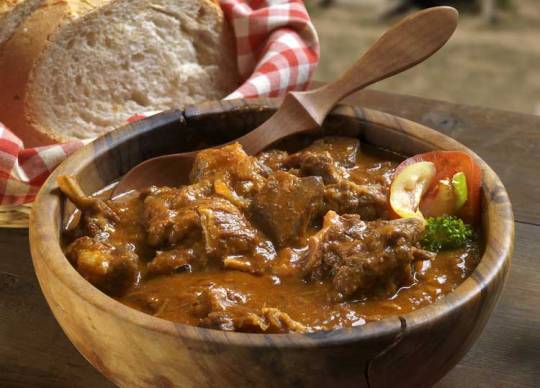
Meat was expensive in medieval times. Why? Because in a time before factory farming it was expensive to raise an animal. Some of you might’ve heard about “economy of scale”, which basically just says, that the more of a thing you produce, the cheaper it will become. And yes, this very much is true for factory farming. (Note: Factory farming is evil, simple as that. No living being should be treated the way, we treat those animals on factory farms.)
So, yes, without factory farms it was just more expensive to make the meat. Which was especially true for smaller animals like chicken. Especially as medieval chicken breeds were smaller than those chickens we see today.
Hence, for a lot of people, meat was just not a thing that they could eat more than once or twice a week. Or, more realistically, a lot of meat was eaten at once, when an animal was slaughtered, while only parts of the animal that could be conserved would then be served over a longer period of time.
It should also be noted that at least Christians tended to use all parts of the animal upon death, including blood and organs. (Muslims did not, as stuff like the blood is not halal.)

Now, one thing that should be noted, is, that most animals that were kept, were kept for multi purposes. Chicken lay eggs. Cows, sheep and goats give milk, with sheep obviously additionally providing wool, making them a very well-beloved animal in medieval times indeed. Horses you can ride. And yes, the pigs were useful, too, as they disposed of garbage, which was why in a lot of places you would just have pigs roaming the streets to take care of that.
Which brings me to the thing, a lot of folks do not want to hear, but… yeah, no, we have sources that tell us that medieval folks did at least also eat their dogs, when those were too old to help on the farm. We do not know how common this was, but we know that it happened. (Just as a note to the white folks getting all snooty about some Asian cultures eating dog meat.)
Of course, game was not kept but hunted. And yes, some people might go out to hunt when they were hungry for meat, but technically speaking it was illegal in many parts of Europe, based on the fact that game living in an area would belong to the nobility owning the land. Now, how those laws were enforced depended a lot on the area and how much game there was. But technically it was considered as such.
About vegetables
Having established that tomatoes, bell peppers, chilies and potatoes were not around in medieval times, this leaves the question: But what was around?
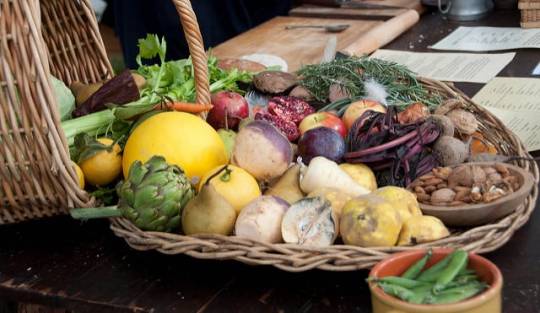
Well, two stable foods we still eat a lot today were definitely around: Carrots and peas. Especially peas were rather cheap and hence were eaten a lot. There was also at least one type of bean around in medieval Europe. Yes, only one. But horse beans were around in medieval Europe and were in fact eaten. Lentils were also quite popular.
Other than that, we also know of turnips, beets, cabbage, kohlrabi, onions and garlic being eaten. But that is not all, as there were several other types of vegetables, that are not around today that much, having been eaten. Especially a lot of root vegetables, like celeriac and parsnip for example.
But also fennel, that tends to be rather unpopular with modern people, was very much around and eaten.
One other vegetable that had some types around in Europe, was the pumpkin. Specifically, the gourd, that originated from Africa, but was cultivated in Europe rather early on.
Also there was a lot of salads and herbs, that also might be eaten as a form of salads.
But how do we know about medieval cuisine?
Another big thing that people tend to be kinda confused about, is, how we know what medieval people ate. Because, yes, at the time books were very expensive and a lot of folks could not read or write. While I will always harp on about the point that we greatly overestimate the number of completely illiterate folks in medieval times, as a lot of people were at least able to read a bit and write down the results of the harvest. But… written language was definitely not the main method of conserving information. Hence, there are only a handful of books around, that are primary texts and are collections of recipes. Most of them originate from noble or royal households, where the chefs would write down what the lord and lady of the house favored.

Other than that, we have a couple of letters, in which people shared their recipes.
But a lot of what we know “existed” is more from mentions within letters and diaries of “today I ate this and that” and historians then trying to figure out what that could have been, based around what we know about the foods that we know were available to the people. At times we also have findings of preserved foods. Now, of course those foods did not preserve for hundreds of years, but we can do chemical testing on what remained and hence figure out what originally had been preserved.
And of course there are pictures we have, that depict foods.
What we thankfully do have, is well documented harvests and things like ledgers from the likes of butchers and farmers based on the stuff they might have sold or given off as a form of taxes (which were often paid in goods, not coin). So, we know at least the raw materials and what might have been available.
And yes, there are also those kind of food that we know where around at ancient times and that are around in some form today. So, we can gather that they have been around the entire time. A good example for this are garlic bread and a version of pizza. We know that even in ancient times people baked bread with garlic butter and bread with vegetables, meat if available and cheese on them. It does not take a genius to figure out that bread with molten cheese on it, is pretty awesome.
Something I want to note as well is, that those recipe books we do have basically all originate from France, Germany and England, with two also originating in Italy. Medieval Europe was more than those four places. Which leads to my issue that a lot of folks tend to ignore that there were cultural differences and that, yes, we kinda are forced to rely on finds and maybe letters. (Believe me, as someone who writes about medieval Wallachia for my fics, it is a pain in the butt.)
But what did medieval people eat?
So, let me overgeneralize a bit. Because again, what you would eat in those times was dependent on where you were living and how wealthy you were. Richer people and nobility would eat meat a lot more often than less wealthy folks.

Generally poor folks would most of the time have some form of porridge for breakfast. That was: Oats cooked in water. If they could afford it, those might be cooked in milk. Maybe with honey. When it was the season, there might’ve been some fruits or nuts in there, too. But most of the times just oats in water. As oats were one of the cheapest forms of corn, they were good for that. Some people might use other corn like rye or barley softened in water as well.
If you could afford it, you might have head bread as well. For most folks it was a rye bread or rye sour dough, because rye was cheaper than wheat. This bread would not be eaten in slices, but rather eaten together with whatever was available. Maybe together with cheese. Maybe dunked in stew or soup. (Which, by the way, leads me to the fact that most taverns only served stew or soup with bread. Not “nice pork grilled over a fire” as we so often see it depicted in media.)
And yes, as a main warm meal there was stew and soup – vegetable soup for the most parts, because again: Meat was expensive. When there was meat in the soup, chances were, that It was all sorts of meats and in fact it was more likely that it would be hare or sheep, rather than pork or poultry. At times the same stew would be eaten for more than a week, with just new stuff being added, whenever it was half-empty, so you might actually get a mix of meats in there. (This was, again, also quite common in taverns, where people might just bring some stuff they had lying around and add it to the so called “everything stew”.) While it might sound disgusting to us today, it actually allowed for pretty deep flavor profiles.

Again, poor folks would often not have a dedicated kitchen or stove and rather would prepare their food over the fire place that was also used to heat the house. Which would lead to a lot of “one pot meals” as we would call it these days. And if there was meat, it often would be prepared as a larger chunk, instead of small cuts being prepared in a pan.
Of course, those were things that rich people could afford more easily. Though this did not necessarily mean nobility, but also folks like tradesmen and the likes. Who not only might have a dedicated kitchen, but also some maid to cook for them.
And there was of course the thing about spices: Medieval cuisine for the most part did not use spices, but only herbs. Because spices mostly originated in North Africa and South Asia and hence had to be traded over long distances. This would make them rather expensive, so many folks were not able to afford them. (Again: the entire colonialism affair started, because everyone wanted spices, while the Ottoman Empire controlled the spice trade.) This does, however, not mean that spice heavy recipes were unknown to medieval folks. They were expensive, yes, but we have both archeological and written evidence from meals, we would today call “curry” being prepared both in England and France.
Milk, no matter what animal it came from, would often be turned into some form of cheese, because most animals would only give milk, when it was season for their young. So, making the milk into cheese was a good way of making the milk last for longer. And yes, lots of folks knew how to make cheese. So, cheese was something that was often enough served to the side. Though dairy as well was not as common as it is today.
Wheat, again, was expensive. So, bread and other food based around wheat was more expensive than rye. Often wheat would only be enjoyed by rich folks and men of the cloth (meaning church folks). And only very rich people could afford white flour based food, while everyone else was eating food based around whole grain flour.
And yes, for the observant ones it should be obvious: Poor folks were eating a lot more healthy, than rich people were. Which led to interesting stuff like the fact that poor people often did not suffer from dental problems, even though dental hygiene was not yet a thing. Simply because they were eating better and less sweet.
Oh, and also: Most people would in fact drink alcoholic beverages (though with a lot less alcohol content than what we know today) instead of just pure water. Why? Well, because chances were, it made you less sick. And yes, also it tasted a lot better than stale water you got from a well. For most folks that was beer or ale, for richer folks wine or at least thinned wine. Except, again, in areas where there was a Muslim majority, because those obviously would not drink alcohol, so there would often be fewer breweries.
Medieval people did not eat badly
Now, let me make one thing clear, because it is a thing I tend to get annoyed by a lot: No, medieval people did not eat badly. Which was the other thing that annoyed me about MatPat’s video, given that the title card was “Medieval Food SUCKS!”, which… no, it doesn’t. It didn’t. It was different, from what we eat today, yes, but it was not bad food.
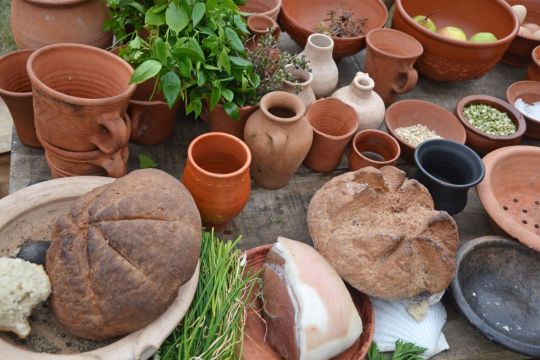
See, it is something that a lot of modern first world folks (especially white folks) are just too picky eaters and with that also kinda wasteful. We will only eat certain bits of dead animals, will not eat a lot of dead animals that are gonna die either way (heck, we have laws against eating certain animals, that are not based in any other reason but people’s emotional attachment to those animals), will not eat many vegetables that would be easier to grow and so on.
And sure, the fact that there was so little spice in medieval food, that makes it kinda… meh. But herbs can be used for those purposes, too. And yes, they can make things rather tasty indeed.
And yeah, I kinda bemoan the way we consume food today. Part of it has a lot to do with capitalism, of course. With the fact that we just do not have the time and means to grow our own food and the fact that of course, that to keep food prices low (which is necessary) but also keep the profits high, food production is plagued by all sorts of inhumanities. Be it slave labor, violence again humans (just look into the history of Chiquita or Dole) and of course the inhumane ways we keep animals.
A lot of folks do not even know how to prepare their own food properly. And do not know where it comes from. And as someone who identifies with the solarpunk culture, I just wish we could change away from that.
So, yeah, Let me just say: The MatPat video was just not that good and ignored an important part of history. Also, a lot of media depicts medieval food culture wrong, leading people to have all sorts of misconceptions about it.

Currently I am writing a fanfic about medieval cooking based around the Castlevania fandom. You can find it on Ao3! Though, yeah, the characters here are rich enough to eat spices.
And if you liked this little rant essay, maybe consider leaving me a little something on Ko-Fi!
#History#medieval cooking#medieval food#food theory#historical cooking#medieval europe#learning#education#middle ages#spain did not exist in the middle ages#white washed#white washed history#long reads#rant post#food history
114 notes
·
View notes
Text
making 3-ingredient peanut butter cookies at dark o'clock because I'm grading historical cooking recipes attempts
the gin and tonic probably helped.
#personal#historical cooking#the professor is in#(in her cups)#one egg one cup sugar one cup nut butter at 350 for 10
11 notes
·
View notes
Text
AWWW YEAHHH it's the return of garum!
youtube
15 notes
·
View notes
Text
Was Medieval peasant food as depressing as we imagine? From simple dishes like bread and fish to treats like pies and sweets, this is everything you need to know about Medieval peasant food.
#Medieval Europe#medieval peasant#sorrel sauce#ancient recipes#food#historical cooking#medieval food#ancient#history#ancient origins
24 notes
·
View notes
Video
youtube
The Poor Man's Pumpkin | Townsends
Who would have thought pumpkin would be an important survival food? In 18th century America, it was a staple for poor folks. Watch to see how they prepared pumpkins for food and what sort of folks were using them.
#Townsends#Jon Townsend#pumpkins#1700's#American Frontier#cooking#recipes#historical cooking#historical recipes#autumn#fall#fall food#Colonial America
11 notes
·
View notes
Text
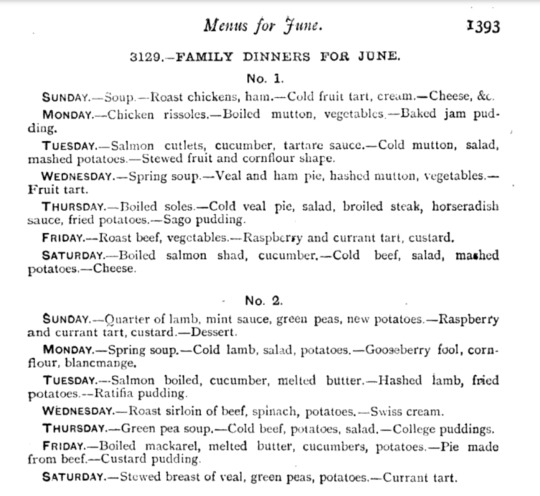
from Mrs. Beeton's Book of Household Management by Isabella Beeton (orig. published 1861; above from the 1888 edition)
#mrs beeton's book of household management#mrs beeton#isabella beeton#victorian era#19th century#food history#antique cookbook#cookbook#victorian food#victorian cookery#19th century food#historical cooking#victorian cooking#history#old cookbook
9 notes
·
View notes
Text

I cooked two recipes from two different cookbooks that are full of transcribed manuscripts from medieval times. One day I am going to do a whole feast, and this will be the fowl portion. I used pork tonight because it's what I had and was included as a possible substitute.
I am very excited about it! It was so good and it wasn't all that hard to make! Just had trouble finding some of the spices in my area (saffron, sandal wood, and the white wine I needed), but it all came together and I couldn't be happier! So excited to try something else! And I have a ton of dough left from the rolls to make two loaves and a few more rolls 😂
#Cooking#Historical Cooking#I have a Manic mood going on#and i had to do something with it!#so i have been cooking
2 notes
·
View notes
Text
Салат « Янус » (The Janus Salad)
(Or: a Russian Englishman’s twist on the Romanov-era Olivier Salad)
007 Fest 2022, Scavenger Hunt item no. 52: “Design a meal or dish of food representing a Bond character. Explain your logic.”

In the days when Janus used to travel all around Russia in his personal armoured train, the question of food always was a critical one. Of course, the on-board kitchen was well-stocked with quality tins, but one did not simply live on a diet of tinned food—especially when one was the immensely rich Janus.
Therefore, some of the Janus Syndicate’s enforcers were specially assigned to catering. They ordered dishes to the greatest chefs in all of Saint Petersburg and brought them back to base (not unlike a private Uber Eats…); they did the grocery shopping at the historical Gostiniy Dvor department store; they even procured rare and/or exotic ingredients from abroad. None of them complained—as long as they weren’t caught red-handed nabbing some of this exceptional food, the job certainly had its advantages.
Janus, as for him, didn’t complain either. As much as he despised his old friend James in those days, he had very much adopted the latter’s love for good, expensive cuisine for himself. While the local restaurateurs never saw him in person, he paid them so generously they came to look forward to the tough-looking henchman’s next visit. There were worse arrangements, especially in 1990s Russia.
What Janus also loved was history—above all else, Romanov history. In another life, he would have certainly been the dashing Count Vronskiy in Tolstoy’s Anna Karenina. Or, at the very least, a young, ambitious Don Cossack officer, relentlessly gaining power in the tsar’s court through intrigue and connections. But alas, he was born a century too late for that to ever happen. His consolation was to devour all the books he could find on the subject… and infiltrating the young Russian Federation’s politics to steer them away from Communism as much as he could.
It was while reading one of his history books that one day, Janus stumbled upon the story of Belgian chef Lucien Olivier and of his most famous creation—Olivier salad. Like every Russian, Janus knew the Soviet, cheapened-down variation of it, also known as Russian potato salad. He was very surprised to find out that the original was, in fact, very posh. Depending on the versions, it could include such ingredients as hazel grouse, crayfish tails, or even black caviar.
Intrigued, Janus kept searching about this historical salad. Chef Olivier had clung jealously to his recipe all the way to the grave, but fortunately some of his contemporaries had noted down their best approximations. The oldest possible source Janus could find was an 1894 article from the long-defunct magazine ‘Our Food’. For what he had in mind, it was a very good base.
So, one day, he summoned one of his caterers and asked for the recipe to be recreated, albeit with a few alterations of his own. The original recipe was forever lost after all, so no need for complete authenticity. Instead of hazel grouse, he wanted partridge—a very acceptable replacement, according to the 1894 article. If he did live the Cossack life, he’d probably have hunted it himself… but the truth was, partridge had been his favourite game meat ever since James made him try some.
Instead of crayfish, he wanted the sweeter, softer scampi. How English of him, one might say. Instead of meat jelly, he wanted the most buttery, decadent beluga caviar—hopefully not from Valentin Zukovsky's Azerbaijani farm, though. He wanted quail eggs, too. And for a slightly dark, smoked edge, he wanted French duck magret. Again, James’ influence on him might be stronger than he’d ever admit…
Lastly, there was the question of the most mysterious ingredient of them all—what the article called ‘Kabul’ sauce. Back in the day, it was a condiment made by the British firm Crosse & Blackwell, but it unsurprisingly had been discontinued eons prior. The replacement, Janus decided, would be a mixture of good old Worcestershire sauce and soy sauce. Russia had borders with China, Korea and Japan after all. Slightly spicy, with a umami kick to it… that resembled enough the descriptions he read.
The henchman finished noting this down, nodded, and went. Shortly before dinner time, he came back to the train with the customary bliny with sour cream and caviar… as well as this.
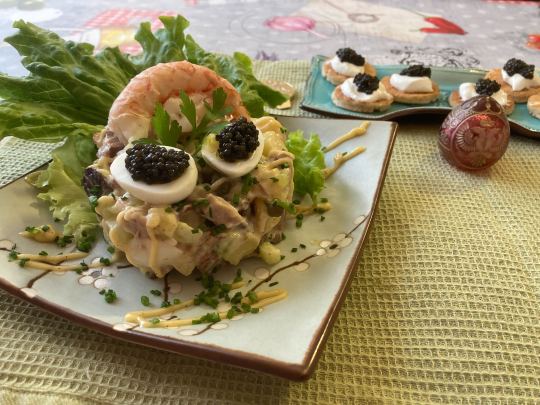
‘Delicious’, Janus thought at the first bite. ‘Well worthy of a tsar… I could call it the Janus salad.’
INGREDIENTS
(DISCLAIMER: the author broke the piggy bank for some of these ingredients because she made this dish for her 26th birthday. Do not feel obliged to do the same—that being said, scouring places such as Petrossian or La Grande Épicerie de Paris (a French equivalent to Harrod’s) was very fun.)

Salad (makes 3-4 servings):
2 roasted partridges (can be replaced with roasted chicken)
8 (+1, see decoration) quail eggs (can be replaced with chicken eggs)
5-6 waxy new potatoes (if you’re Janus, you’ll probably want Jersey Royals. If you’re a French frog like the author, Noirmoutiers are an excellent replacement.)
70g smoked duck magret (omit if you don’t have access to it)
Half an English cucumber
1 tbsp capers
10 black olives
Meat from the scampi claws
Scampi broth (if raw scampi are used):
Parsley
Tarragon
Dill
2 bay leaves
1 onion, quartered
1 carrot, chopped
Jamaican pepper (Bond would approve)
Coarse salt
Provençal sauce:
1 egg yolk
1 tsp Dijon mustard
2 tsp vinegar
olive oil (or olive oil + a neutral tasting oil—olive oil has a strong taste)
black pepper
garlic powder
2 tsp Worcestershire sauce
2-3 tsp soy sauce
For the decoration of 1 serving:
2 scampi (aka. langoustines)
1 lettuce leaf
The spare quail egg, halved
Chives
Black caviar (if you’ve got Janus’ unlimited funds, beluga is a must—since the author hasn’t, she used osetra instead. A good, much cheaper replacement with a similar taste would be trout roe... except it isn't as dark as Alec's soul 😆)
DIRECTIONS
Roast the partridge (or chicken) and let it cool down
Boil the potatoes and let them cool down
Boil the quail eggs for 3 minutes and let them cool down (8 minutes for chicken eggs)
Make the scampi broth. When it boils, add the raw scampi and cook for 8 minutes starting from when the broth boils again. Remove the pot from the stove and put it in a cold water bath. Leave the pot to cool down, so that the scampi are infused with the broth.
Remove the bones from the partridge/chicken, then chop it up into small pieces along with the potatoes, cucumber, magret, eggs and meat from the scampi claws. Add capers and sliced olives
Make the Provençal sauce. Mix the egg yolk and mustard then slowly add oil while whisking, until texture is firm (an electric hand mixer helps). Add the other ingredients and mix well.
Add two generous tablespoons of Provençal sauce to the salad, then gently mix it all up.
To serve, ideally use a ring mold. Decorate the molded salad with the scampi, egg, lettuce leaf, caviar and chives.
Serve very cold. The 1894 recipe says that it should be ideally done in ‘a crystal vase, like fruit macédoine’.
Приятного аппетита! (Bon appétit!)
SOURCES:
https://en.wikipedia.org/wiki/Olivier_salad (good overview)
https://liveuser.livejournal.com/77282.html (the 1894 recipe, in Russian)
https://stale.ru/en/different/olive-s-rakovymi-sheikami-gotovim-originalnye-salaty-olive-s/ (different variations of the original recipe with more complete instructions, Google (?) translated from Russian)
BONUS PICTURES:

Mmm roasted partridge
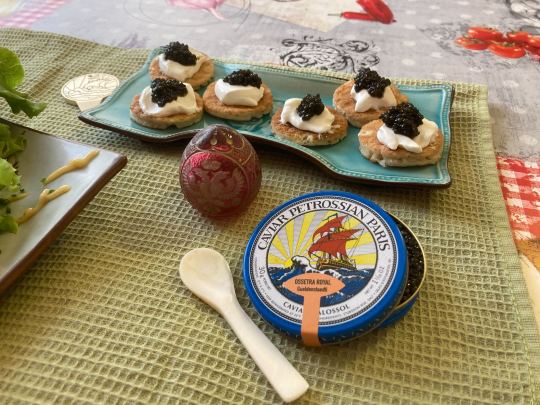
A good view on that caviar (I certainly am not going to get more any time soon, so gotta show off 😁). Also, six bliny of course.

Little birthday dessert in the same spirit:
Georgian black tea with lemon
Chocolate, lemon, raspberry and mango macarons
‘Cigarettes russes’ (Russian cigarettes), which are Belgian rolled biscuits
Raisin and lemon Scottish shortbread
Apple and honey ‘tulskiy pryanik’, a sort of gingerbread from Tula, Russia
PS: did you spot the three Sean Bean non-Alec Easter eggs in the opening blurb? 👀
#007 Fest#007 Fest 2022#Team00#scavenger hunt#mi6caferecipes#james bond#007#goldeneye#alec trevelyan#breaking the bank#silverova showing off with her cooking#this was quite some work to make#but so fun#living the janus life#historical cooking#romanov era#olivier salad
36 notes
·
View notes
Text


#fashion#hot#food#in style#baking#romans#recipes#breads#dishes#cakes#honey#mediterranean#ideas#historians#historical cooking
4 notes
·
View notes
Text
I really start thinking about creating some original recipes and just share historical recipes on some different vegetables.
I am right now for health reasons forced to a vegetarian diet and I am honestly very shocked how boring so many of the recipes are - especially as they seem to use the same like five vegetables again and again, rather than using the whole spectrum.
I don't know. Would anyone be interested in that?
18 notes
·
View notes
Text
The Evolution of Posset.
youtube
Wow, they really gentrified the heck out of posset over the years, LOL. Ryan describes the taste of this 18th century posset recipe as "coffee in cereal" and the texture is... well. I mean hey, it's calories. Carbs and dairy fat are a tried-and-true combo across time and cultures. But after years of Jon's cooking I can't be the only one to wonder if the posset might be helped by a scrape of nutmeg...
6 notes
·
View notes
Text
Do I have the coolest job in the world? Or do I have the coolest job in the world?
Bear meat:

Iguana and plantains, and cheese on the left
Bison (the strips) and elk (the chunks), oyster (or clam?) bread (the pale lump) and persimmon bread (dark on the left).

2 notes
·
View notes
Text


MAKKE (c. 1390)
Time for a peasant-style, medieval, midweek dish, because I'm no royal, and this is probably closer to what I'd be eating if I actually did go back in time. The historical dish from Tasting History I tried this past Thursday evening after work was Makke, a medieval peasant-style dish from England. While we don't know for sure that peasants ate this, because the recipe, c. 1390, is also sourced from the Forme of Curry (recipes used to feed the court of Richard II of England), it is one of the few dishes therein that doesn't use expensive herbs or spices and contains only a few easily-accessible ingredients for the average peasant. See Max’s video on how to make it here or see the ingredients and process at the end of this post, sourced from the Youtube description of the video.
My experience making it:
I made a change or two from the modern recipe below: I used white gigante/corona beans (Weiße Riesenbohnen, where I live) instead of fava or broad beans, because I couldn't find fava or broad beans readily, and the white beans would hopefully end up white, like the original recipe describes. Max mentions that the red wine listed in the original recipe would likely not have been used by peasants, as beer was closer to hand, so I also decided to use beer instead of red wine - specifically Gaffel Wiess. Gaffel Wiess is a top-fermented beer from the Cologne region of Germany; it is light, unfiltered, and naturally cloudy, much how I imagine a peasant's beer might be due to lack of modern filtration equipment. Until the mid-20th century, Wiess was the main drink of the people of Cologne, the forefather of the modern and popular Kölsch beer.
The process of making Makke was marvelously simple, making it perfect for a quick midweek meal. The recipe took me only 20 minutes (or less!) to make. Like Max mentioned, I added only half a cup of beer to the mashed beans at first, and added more until it was more of the consistency I was after - similar to mashed potatoes. I also needed to mix in a decent amount of salt in order to add a bit of flavour to the mixture (no fancy royal herbs allowed!). The onions fried up perfectly and added a much-needed colour dimension to the plain-looking dish. I was content that despite using a different type of bean, my Makke looked nearly identical to Max’s!
My experience tasting it:
Serving the Makke forth along with a garden salad, a bit of bread and butter, and the rest of the Gaffel Wiess beer, my husband and I tried the first bite with a bit of the onion, and we were quite happy with the flavour! I'm not sure if it was the mashed consistency (which reminded me of my favourite dish, mashed potatoes) or the crisp and sweet onions, but this dish was easy to inhale and spoon down pretty quick. Makke is in no way out of place in a modern diet, in my opinion. Sure, after a couple spoonfuls I may have added a little black pepper to give it some more bite, but the foundation of this dish is good. I will definitely make this dish again, although perhaps with the powers of a modern pantry, including all of the delightful herbs and spices that only a 16th century royal would have possessed. The fact that this dish is tasty and quick to prepare means that it is a great addition to our midweek meal repertoire. If you end up making it, if you liked it, or if you changed anything from the original recipe, do let me know!
Links to harder-to-find ingredients:
Fava/Broad beans
Makke original recipe (c. 1390)
Sourced from The Forme of Curry
How to make Makke
Take drawen benes and seeth them well. Take them up of the water and cast them in a morter grynde them all to doust till thei be white as eny mylk. Chawf a little rede wyne, cast thereamong in the gryndyng, do therto salt, leshe it in disshes. Thenne take Oynouns and mynce them smale and seeth them in oile til they be al broun, and florissh the dishes therwith. And serve it forth.
Modern Recipe
Based on The Forme of Curry and Max Miller’s version in his Tasting History video.
Ingredients:
3 cups (450g) fava/broad beans (or any other bean)
1/2 cup - 1 cup (118 ml - 236 ml) red wine or ale
salt to taste
1 onion minced (white or yellow)
oil or butter for frying
water for boiling
Method:
Wash and boil the beans over a medium heat until soft.
Remove the beans from the water and mash them until smooth.
Warm the wine or ale over a low heat and mix with the beans. Start with 1/2 cup and add more to achieve desired consistency.
Mix in salt to bean mixture to taste.
Place a large pan over medium heat and add the butter or oil.
Add the minced onion and fry until golden brown, about 7-10 minutes.
When onions looking sufficiently brown, garnish onions on top of the beans.
Serve it forth.
#16th century#Makke#richard ii#richard ii of england#Forme of Curry#tasting history#max miller#tasting history with max miller#beans#beer#medieval meals#keepers#peasant meals#cooking#historical cooking
0 notes
Text
It is well known that some persons like cheese in a state of decay, and even 'alive'. There is no accounting for tastes, and it may be hard to show why mould, which is vegetation, should not be eaten as well as salad, or maggots as well as eels. But, generally speaking, decomposing bodies are not wholesome eating, and the line must be drawn somewhere.
-- Page 95, Isabella Beeton, "The Campaign for Domestic Happiness"
#isabella beeton#the campaign for domestic happiness#victorian#victorian food#mrs beeton's book of household management#cookery#cheese#historical cooking#food history
0 notes
Text
youtube
I actually tried making this spice recipe today and it worked pretty well.
0 notes